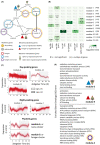Hijacking time: How Ophiocordyceps fungi could be using ant host clocks to manipulate behavior
- PMID: 35103986
- PMCID: PMC9287076
- DOI: 10.1111/pim.12909
Hijacking time: How Ophiocordyceps fungi could be using ant host clocks to manipulate behavior
Abstract
Ophiocordyceps fungi manipulate ant behaviour as a transmission strategy. Conspicuous changes in the daily timing of disease phenotypes suggest that Ophiocordyceps and other manipulators could be hijacking the host clock. We discuss the available data that support the notion that Ophiocordyceps fungi could be hijacking ant host clocks and consider how altering daily behavioural rhythms could benefit the fungal infection cycle. By reviewing time-course transcriptomics data for the parasite and the host, we argue that Ophiocordyceps has a light-entrainable clock that might drive daily expression of candidate manipulation genes. Moreover, ant rhythms are seemingly highly plastic and involved in behavioural division of labour, which could make them susceptible to parasite hijacking. To provisionally test whether the expression of ant behavioural plasticity and rhythmicity genes could be affected by fungal manipulation, we performed a gene co-expression network analysis on ant time-course data and linked it to available behavioural manipulation data. We found that behavioural plasticity genes reside in the same modules as those affected during fungal manipulation. These modules showed significant connectivity with rhythmic gene modules, suggesting that Ophiocordyceps could be indirectly affecting the expression of those genes as well.
Keywords: Zombie ants; behavioural plasticity; circadian plasticity; entomopathogens; infectious disease.
© 2022 The Authors. Parasite Immunology published by John Wiley & Sons Ltd.
Conflict of interest statement
The authors have no conflict of interest to declare.
Figures

References
-
- Poulin R, Morand S. The diversity of parasites. Q Rev Biol. 2000;75(3):277‐293. - PubMed
-
- Andersen SB, Gerritsma S, Yusah KM, et al. The life of a dead ant: the expression of an adaptive extended phenotype. Am Nat. 2009;174:424‐433. - PubMed
-
- Hughes DP, Araújo JPM, Loreto RG, Quevillon L, de Bekker C, Evans HC. From so simple a beginning. The evolution of behavioral manipulation by fungi. Adv Genet. 2016;437‐469. - PubMed
Publication types
MeSH terms
LinkOut - more resources
Full Text Sources

